For most visitors to Malaysia ethnic Malay food will only be part of the overall Malaysian food experience, with the prominence of other colonial influences often just as noticeable. Malaysia is obviously a big country and regional influences vary from the far flung borders of the Philippines and Indonesia in Borneo, to the mixing pot of colonial settlements on the west coast of Peninsular Malaysia. The three prominent cooking cultures found in today’s Malaysia include; Malay, Chinese and Indian which is also reflected in the demographic makeup of the main tourist hubs of Penang (45% Chinese, 40% Malay, 10% Indian) and Kuala Lumpur (45% Malay, 43% Chinese, 10% Indian). So a better representation of modern, Malaysian food should explore all three cuisines. To name some of my favourite Malaysian food experiences while holiday in Penang, Kuala Lumpur (KL), I would include the street food and food courts of George Town (Penang), the prominence of Indian Muslim Food (Mamak) on the west coast, and Jalan Alor of Kuala Lumpur, one of the most impressive street food streets I’ve found to date. Malaysian foods are also similar to their nearby neighbours in Singapore, only in Malaysia the prices are quite a bit cheaper. Here are some of my Top Malaysian food for any visit and holiday in Malaysia.
Nasi Campur (Nasi Kandar and Nasi Padang)
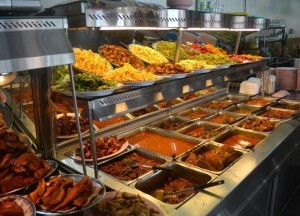 Canteen style curry buffets serving hot pre-cooked dishes and other tasty sides. Grab a plate, pile on the rice and take your pick from the buffet. Nasi Campur (which translates as ‘mixed rice’) often offers tens to hundreds of Malaysian food alternatives and they make well for an introduction to eating in Malaysia. Again there will be regional variations with Nasi Campur where in North Malaysia the Nasi Kandar is a more popular Indian inspired alternative; while in the South of Malaysia Nasi Padang offers a more Malay and Indonesian style of cuisine. Nasi Campur can be found at almost every food court, hawker area or shop house street in Malaysia and is likely the most common eating option in the country. Final prices normally depend on the number, and size of portions you take, but are more than not, unbelievably cheap. It is the norm in many Malay restaurants for locals to eat with their hands, but fork and spoon are also an option. Either way the food tastes the same. Note, table etiquette is to eat with the right hand (the left used for peeing etc).
Canteen style curry buffets serving hot pre-cooked dishes and other tasty sides. Grab a plate, pile on the rice and take your pick from the buffet. Nasi Campur (which translates as ‘mixed rice’) often offers tens to hundreds of Malaysian food alternatives and they make well for an introduction to eating in Malaysia. Again there will be regional variations with Nasi Campur where in North Malaysia the Nasi Kandar is a more popular Indian inspired alternative; while in the South of Malaysia Nasi Padang offers a more Malay and Indonesian style of cuisine. Nasi Campur can be found at almost every food court, hawker area or shop house street in Malaysia and is likely the most common eating option in the country. Final prices normally depend on the number, and size of portions you take, but are more than not, unbelievably cheap. It is the norm in many Malay restaurants for locals to eat with their hands, but fork and spoon are also an option. Either way the food tastes the same. Note, table etiquette is to eat with the right hand (the left used for peeing etc).
Fish Head Curry
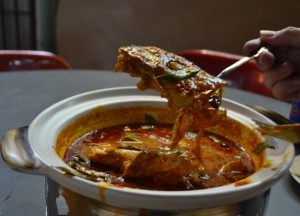 One of the most popular Nasi Campur options has to be the fish head curry which is one of my all time favourite foods. While Malaysia claim this dish to be their own, the fish head curry is said to originate in Singapore and reflects both Indian and Chinese cultures as it came to existence when an Indian chef added fish head to his curry, in an attempt to please Chinese customers. This fiery hot fish head curry includes the head of a red snapper, lots of veg and a soupy, spicy south Indian style curry sauce. While a full curry is optional on many menus, the fish head curry is better found at Nasi Kandar curry buffets.
One of the most popular Nasi Campur options has to be the fish head curry which is one of my all time favourite foods. While Malaysia claim this dish to be their own, the fish head curry is said to originate in Singapore and reflects both Indian and Chinese cultures as it came to existence when an Indian chef added fish head to his curry, in an attempt to please Chinese customers. This fiery hot fish head curry includes the head of a red snapper, lots of veg and a soupy, spicy south Indian style curry sauce. While a full curry is optional on many menus, the fish head curry is better found at Nasi Kandar curry buffets.
Beef Rendang
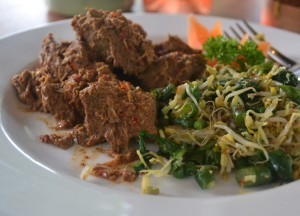 Better known for its origins in Indonesia the spicy beef rendang is also common to Malaysia where it again can be found at the Nasi Campur curry buffets (if lucky). Rendang is a stewed beef dish simmered in coconut milk with a spice paste mix of ginger, turmeric and fiery chillies. It also take hours to perfect through slow cooking so it is found better at pre-cooked curry buffets than quick stir fry restaurants and food courts. After hours of perfecting, the resulting Rendang should be served dry, rich and caramelized as a beef masterpiece, although there are more saucy adaptations.
Better known for its origins in Indonesia the spicy beef rendang is also common to Malaysia where it again can be found at the Nasi Campur curry buffets (if lucky). Rendang is a stewed beef dish simmered in coconut milk with a spice paste mix of ginger, turmeric and fiery chillies. It also take hours to perfect through slow cooking so it is found better at pre-cooked curry buffets than quick stir fry restaurants and food courts. After hours of perfecting, the resulting Rendang should be served dry, rich and caramelized as a beef masterpiece, although there are more saucy adaptations.
Nasi Lemak
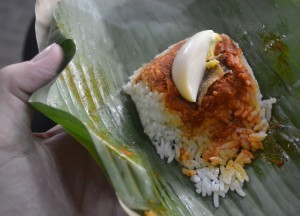 Nasi Lemak is a staple in Malaysia’s eating and, while not a big fan myself (overly fishy anchovies), it’s a dish you can’t really miss. Nasi Lemak brings an enticing mix of flavours with coconut rice, crispy anchovies (ikan bilis), roasted peanuts and a fiery sambal sauce (ground chillies, lime and toasted shrimp paste). While it is the preferred breakfast of Malaysia, it can also be found day round, almost everywhere. Nasi Lemak often comes wrapped tight in banana leaves and sold alongside grilled meats and other optional extras. Good (and extremely cheap) as a meal on it’s own, but does come better served with grilled or fried chicken.
Nasi Lemak is a staple in Malaysia’s eating and, while not a big fan myself (overly fishy anchovies), it’s a dish you can’t really miss. Nasi Lemak brings an enticing mix of flavours with coconut rice, crispy anchovies (ikan bilis), roasted peanuts and a fiery sambal sauce (ground chillies, lime and toasted shrimp paste). While it is the preferred breakfast of Malaysia, it can also be found day round, almost everywhere. Nasi Lemak often comes wrapped tight in banana leaves and sold alongside grilled meats and other optional extras. Good (and extremely cheap) as a meal on it’s own, but does come better served with grilled or fried chicken.
Char Kway Teow
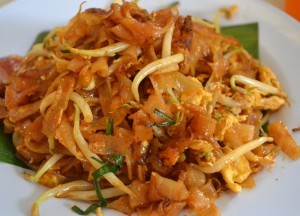 Char Kway Teow, for me, is the Pad Thai of Malaysia (or it could go the opposite). ‘Rice cake strips’ stir fried with egg, beansprouts, chives, and more than not prawns. Flavoured with soy sauce. Char Kway Teow is simple, flavorsome and makes a good start for Malaysian food… but do go further. It is one of the most common Malay dishes found throughout the country, and will again vary regionally often served with cockles, fishcakes and other additions and flavourings.
Char Kway Teow, for me, is the Pad Thai of Malaysia (or it could go the opposite). ‘Rice cake strips’ stir fried with egg, beansprouts, chives, and more than not prawns. Flavoured with soy sauce. Char Kway Teow is simple, flavorsome and makes a good start for Malaysian food… but do go further. It is one of the most common Malay dishes found throughout the country, and will again vary regionally often served with cockles, fishcakes and other additions and flavourings.
Mee Goreng
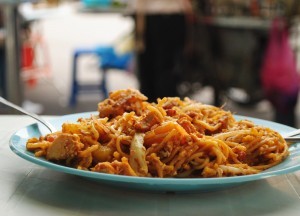 So, I’m going to be lazy here and bunch a number of noodle dishes together. A similar dish to Char Kway Teow would be Kuay Teow Goreng, where in Malay the word Goreng simply means fried. Replace the Kuay Teow (rice cake strips) with Egg Noodles (Mee) and we have mee goreng (below left). These can alternate with all sort of noodles, and all sorts of regional variations. Fried noodle dishes can keep you busy with Malaysian food, but in my opinion, they’re not overly exciting. Also look out for an Indian inspired noodle dish in Mee Mamak (below right).
So, I’m going to be lazy here and bunch a number of noodle dishes together. A similar dish to Char Kway Teow would be Kuay Teow Goreng, where in Malay the word Goreng simply means fried. Replace the Kuay Teow (rice cake strips) with Egg Noodles (Mee) and we have mee goreng (below left). These can alternate with all sort of noodles, and all sorts of regional variations. Fried noodle dishes can keep you busy with Malaysian food, but in my opinion, they’re not overly exciting. Also look out for an Indian inspired noodle dish in Mee Mamak (below right).
Curry Mee
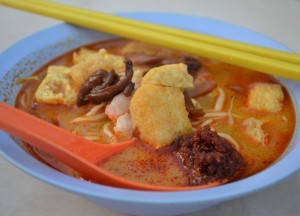 Curry Mee is my preferred eggy alternative to the better known ‘Curry Laksa’. The main difference between the two is that ‘Mee’ are egg noodles while laksa are thick rice noodles. The curry in Curry Mee is a coconut-based curry soup, served over egg noodles, with fried tofu, crunchy additions of beansprouts and occasional cubes of congealed blood. I also find Curry Mee to be one of the most common hawker foods in Malaysia and, as a curry lover, is a personal favourite. To use a comparison with Thai food again (sorry) it would maybe come closest to the favourite Khao Soi Curry, only more Indian inspired. Definitely on the must-eat list.
Curry Mee is my preferred eggy alternative to the better known ‘Curry Laksa’. The main difference between the two is that ‘Mee’ are egg noodles while laksa are thick rice noodles. The curry in Curry Mee is a coconut-based curry soup, served over egg noodles, with fried tofu, crunchy additions of beansprouts and occasional cubes of congealed blood. I also find Curry Mee to be one of the most common hawker foods in Malaysia and, as a curry lover, is a personal favourite. To use a comparison with Thai food again (sorry) it would maybe come closest to the favourite Khao Soi Curry, only more Indian inspired. Definitely on the must-eat list.
Satay
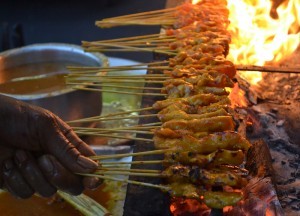 Satay is quintessential barbecue food. Tender meat pieces, marinated and skewered, and grilled over flaming hot charcoals. Satay will normally come served with a fiery, hot peanut sauce, which can vary throughout regions. With satay sauce I find the better interpretations found closest to its origins in Java Indonesia, and many Malaysian variations come served with a sweeter, less fiery, and ultimately less exciting satay sauce. An increasingly popular street food version would be satay chicken wings.
Satay is quintessential barbecue food. Tender meat pieces, marinated and skewered, and grilled over flaming hot charcoals. Satay will normally come served with a fiery, hot peanut sauce, which can vary throughout regions. With satay sauce I find the better interpretations found closest to its origins in Java Indonesia, and many Malaysian variations come served with a sweeter, less fiery, and ultimately less exciting satay sauce. An increasingly popular street food version would be satay chicken wings.
Loh Mee
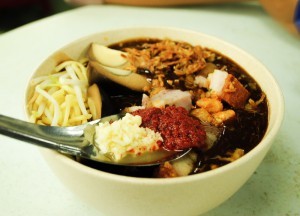 A personal favourite from the Penang area would be Loh Mee a bowl of think egg noodles stewed in a gooey egg based broth. What I love about this uniquely Malay noodle dish while holiday in penang is the deliciously crispy pork pieces and deep fried pork skins which hide inside. Loh Mee comes served with crunchy beansprouts, crispy fried onions, boiled duck egg and the added option of vinegared garlic or spicy chili paste. Loh mee originates from, and is best found in the Penang area.
A personal favourite from the Penang area would be Loh Mee a bowl of think egg noodles stewed in a gooey egg based broth. What I love about this uniquely Malay noodle dish while holiday in penang is the deliciously crispy pork pieces and deep fried pork skins which hide inside. Loh Mee comes served with crunchy beansprouts, crispy fried onions, boiled duck egg and the added option of vinegared garlic or spicy chili paste. Loh mee originates from, and is best found in the Penang area.
Hokkien Mee
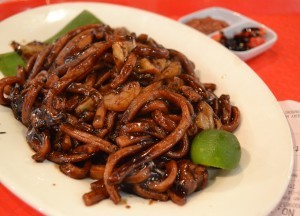 While I bunched fried noodle dishes together earlier, I do feel Hokkien Mee (Hokkien Char Mee) deserve an honorable mention. Named after its origins in the Chinese Fujian (Hokkien) Province; Hokkien Mee has generated an ongoing regional rivalry but for me the Kuala Lumpur (KL) version is hard to beat. KL Hokkien Mee come served as thick egg noodles, stir fried with pork lard, pork and prawns, all braised in a rich and thick dark soy sauce. Served with sides of lime, sliced red chili, soy sauce and sambal.
While I bunched fried noodle dishes together earlier, I do feel Hokkien Mee (Hokkien Char Mee) deserve an honorable mention. Named after its origins in the Chinese Fujian (Hokkien) Province; Hokkien Mee has generated an ongoing regional rivalry but for me the Kuala Lumpur (KL) version is hard to beat. KL Hokkien Mee come served as thick egg noodles, stir fried with pork lard, pork and prawns, all braised in a rich and thick dark soy sauce. Served with sides of lime, sliced red chili, soy sauce and sambal.
Wonton Mee
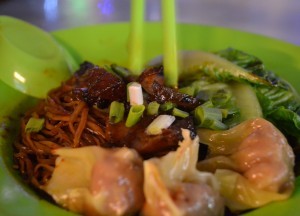 Chinese inspired, dough skin dumplings stuffed with ground pork and shrimp, and boiled in a soup. While there are many regional variations to Wonton Mee the most common bowl comes with dry egg noodles, cooked in soy and oyster sauce. The noodles are then served either in soup, or with soup on the side, and more than not, accompanied by boiled Chinese broccoli. While Char Siu (red pork) is the common topping for Wonton Mee I often find all sorts of meaty Chinese favourites such as roast duck or fried pork belly. Another modern variation includes deep fried wontons on the side, instead of being boiled in the soup.
Chinese inspired, dough skin dumplings stuffed with ground pork and shrimp, and boiled in a soup. While there are many regional variations to Wonton Mee the most common bowl comes with dry egg noodles, cooked in soy and oyster sauce. The noodles are then served either in soup, or with soup on the side, and more than not, accompanied by boiled Chinese broccoli. While Char Siu (red pork) is the common topping for Wonton Mee I often find all sorts of meaty Chinese favourites such as roast duck or fried pork belly. Another modern variation includes deep fried wontons on the side, instead of being boiled in the soup.
Claypot Chicken Rice
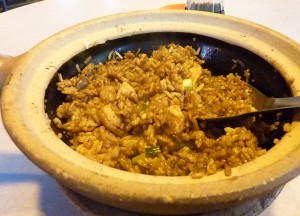 A simple, mixed clay pot of rice, heated and slow-cooked over charcoal stoves with stock and chicken. Cooking times take around 20 to 30 minutes before serving direct in the clay pot as the pot holds in the heat. While this simple rice bowl doesn’t sound overly special I love the delicious crisp crust, and smoky flavour from the clay pot cooking. A clay pot can be a meal for one, but it maybe better to share. For an exciting Indian alternative keep a eye out for the Clay Pot Biryani (next).
A simple, mixed clay pot of rice, heated and slow-cooked over charcoal stoves with stock and chicken. Cooking times take around 20 to 30 minutes before serving direct in the clay pot as the pot holds in the heat. While this simple rice bowl doesn’t sound overly special I love the delicious crisp crust, and smoky flavour from the clay pot cooking. A clay pot can be a meal for one, but it maybe better to share. For an exciting Indian alternative keep a eye out for the Clay Pot Biryani (next).
Biryani Rice
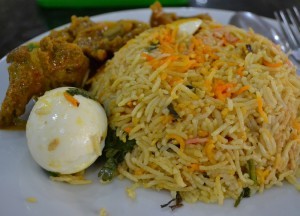 This Indian influenced Malaysian favourite is a layered rice dish fusing together an aromatic and flavoursome sauce of local spices.Common spices in Malaysian Biryani include cardamom and chili powders with a layering of yogurt. Biryani is a common staple at Malaysia’s Mamak (Indian Muslim) restaurants, and while good as a meal in itself, it does come better matched with mutton curry or cuts of tandoori chicken. Note, Mamak restaurants are always Halal meaning no pork.
This Indian influenced Malaysian favourite is a layered rice dish fusing together an aromatic and flavoursome sauce of local spices.Common spices in Malaysian Biryani include cardamom and chili powders with a layering of yogurt. Biryani is a common staple at Malaysia’s Mamak (Indian Muslim) restaurants, and while good as a meal in itself, it does come better matched with mutton curry or cuts of tandoori chicken. Note, Mamak restaurants are always Halal meaning no pork.
Roti Canai
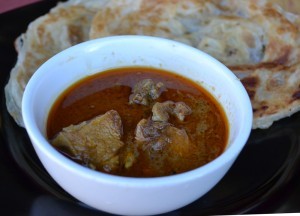 The second, more common staple in Mamak food is Roti Canai a humble pan-fried flatbread better known for its authentic origins in India. Orders of Roti Canai come served with sides of curry sauce and can be eaten as a meal on its own… but meaty side orders of chicken, mutton or goat curry (again pork forbidden in Halal) are always welcome. Beyond the simple Roti; variations include murtabak with layered Rotis stuffed with meats. Another is Kotthu where Roti is cut and mixed with meat and egg. Again each meal will come served with condiments of curry.
The second, more common staple in Mamak food is Roti Canai a humble pan-fried flatbread better known for its authentic origins in India. Orders of Roti Canai come served with sides of curry sauce and can be eaten as a meal on its own… but meaty side orders of chicken, mutton or goat curry (again pork forbidden in Halal) are always welcome. Beyond the simple Roti; variations include murtabak with layered Rotis stuffed with meats. Another is Kotthu where Roti is cut and mixed with meat and egg. Again each meal will come served with condiments of curry.
Tandoori Chicken
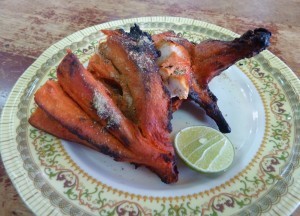 Tandoori is the term used for foods cooked in the Tandoor – a giant earthenware oven, and it is the secret behind many of the favourite Mamak foods in Malaysia. The obvious favourite would be Tandoori Chicken with chicken pieces first marinated in spices overnight to absorb the flavour, then skewered and cooked the following day inside the Tandoor. The resulting chicken is tender on the inside, and crisp and tasty on the out. Other popular Tandoori treats include Chicken Tikka and Naan flatbreads.
Tandoori is the term used for foods cooked in the Tandoor – a giant earthenware oven, and it is the secret behind many of the favourite Mamak foods in Malaysia. The obvious favourite would be Tandoori Chicken with chicken pieces first marinated in spices overnight to absorb the flavour, then skewered and cooked the following day inside the Tandoor. The resulting chicken is tender on the inside, and crisp and tasty on the out. Other popular Tandoori treats include Chicken Tikka and Naan flatbreads.
Steamboat Hot Pots
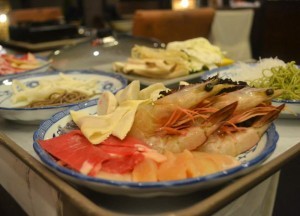 Steamboats, or Hot Pots as better known elsewhere, were introduced by Chinese traders in the colonial era of Malaysia, and quickly became popular in the Highlands as a food to keep warm in cooler evening hours. Hot Pots are hands-on eating; choose your meats, your veg, your noodles, throw them into the soup stock and cook through. Steamboats often come with split broths and the local Malay ‘Soto’ spiced chicken soup broth is often the most common; but other enticing options may include Malay style curry, satay, or assam soups or even a Thai tom yum, or the mouth numbing Sichuan Peppercorn. Serve meats and soups in small bowls, with sides of hot, sour and tangy dips.
Steamboats, or Hot Pots as better known elsewhere, were introduced by Chinese traders in the colonial era of Malaysia, and quickly became popular in the Highlands as a food to keep warm in cooler evening hours. Hot Pots are hands-on eating; choose your meats, your veg, your noodles, throw them into the soup stock and cook through. Steamboats often come with split broths and the local Malay ‘Soto’ spiced chicken soup broth is often the most common; but other enticing options may include Malay style curry, satay, or assam soups or even a Thai tom yum, or the mouth numbing Sichuan Peppercorn. Serve meats and soups in small bowls, with sides of hot, sour and tangy dips.
Lok Lok Hot Pot
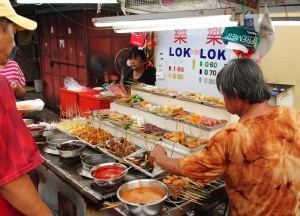 A second Malaysian Hot Pot option is Lok Lok, not so different to Steamboat restaurants, only they are more commonly found as street food and as an option to eat on the go. The obvious difference between the two is that Lok Lok uses skewered bites which are dunked into the hot pot broth and are easy to eat in a hurry. Lok Lok comes with all sorts of meat and veg options, cooked in all sorts of flavoured broths and can be dunked in a number of chilli dips and gravies (similar to steamboats). At street food areas you will often find small tables which host built in Lok Lok pots.
A second Malaysian Hot Pot option is Lok Lok, not so different to Steamboat restaurants, only they are more commonly found as street food and as an option to eat on the go. The obvious difference between the two is that Lok Lok uses skewered bites which are dunked into the hot pot broth and are easy to eat in a hurry. Lok Lok comes with all sorts of meat and veg options, cooked in all sorts of flavoured broths and can be dunked in a number of chilli dips and gravies (similar to steamboats). At street food areas you will often find small tables which host built in Lok Lok pots.
Rojak
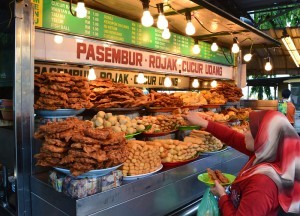 Rojak mixes the sweets and sours of Malaysia’s regional fruits with the spicy and hot of a rich chilli and tamarind fused dressing. Fruits will again vary through regions of Malaysia and with the seasons of the year, but the more common bites include water apple, pineapple and sour unripe mangoes. To be confusing the word Rojak simply means “mixture” in Malay and another common style of rojak is “Pasembur”, an Indian Halal mixed salad of vegetables and deep fried bites and nibbles, topped with a sweet and hot chilli sauce.
Rojak mixes the sweets and sours of Malaysia’s regional fruits with the spicy and hot of a rich chilli and tamarind fused dressing. Fruits will again vary through regions of Malaysia and with the seasons of the year, but the more common bites include water apple, pineapple and sour unripe mangoes. To be confusing the word Rojak simply means “mixture” in Malay and another common style of rojak is “Pasembur”, an Indian Halal mixed salad of vegetables and deep fried bites and nibbles, topped with a sweet and hot chilli sauce.
Ais Kacang
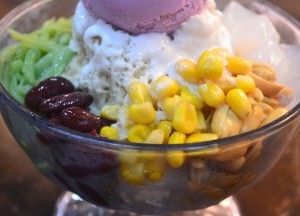 Shaved ice is a common dessert in most Asian countries, but for me the best is found in Malaysia with the Ais Kacang, a mix of shaved ice with variations of fruits, beans, ice-creams and syrups. As expected ingredients will vary from one place to the next, but the traditional mix comes served with red beans, sweet corn, grass jelly and cubes of green agar jelly. Ais Kacang is one of the most popular desserts in Malaysia found at almost every food court and dessert menu.
Shaved ice is a common dessert in most Asian countries, but for me the best is found in Malaysia with the Ais Kacang, a mix of shaved ice with variations of fruits, beans, ice-creams and syrups. As expected ingredients will vary from one place to the next, but the traditional mix comes served with red beans, sweet corn, grass jelly and cubes of green agar jelly. Ais Kacang is one of the most popular desserts in Malaysia found at almost every food court and dessert menu.
Durian
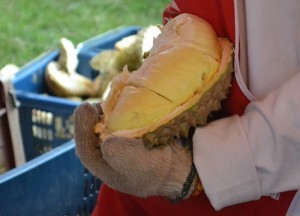 Durian is both feared and revered in Malaysia as the formidable King of Fruits. For those who brave past the somewhat alien-esque shell, and pungent smell, you can expect a lifelong obsession for the sweet, creamy and perfect fruit inside. Or you may hate it. There’s definitely a love, hate relationship with the Durian with the common phrase ‘tastes like heaven smells like hell’. As with most fruits, the Durian is seasonal, and harvests are found more than not, between June and October.
Durian is both feared and revered in Malaysia as the formidable King of Fruits. For those who brave past the somewhat alien-esque shell, and pungent smell, you can expect a lifelong obsession for the sweet, creamy and perfect fruit inside. Or you may hate it. There’s definitely a love, hate relationship with the Durian with the common phrase ‘tastes like heaven smells like hell’. As with most fruits, the Durian is seasonal, and harvests are found more than not, between June and October.
Teh Tarik
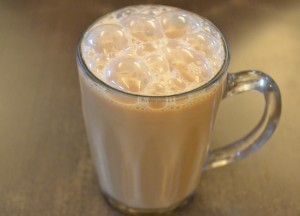 As with almost everywhere in the world Coffee and Tea are both daily essentials in Malaysia, and are both found almost everywhere. Teh Tarik or “pulled tea” is the most common example, a mixture of black tea and condensed milk, poured back and forth, often from height, to give a frothy top. Being more of a coffee lover I opt instead for the Kopi O (Hot Black Coffee). While both are found almost everywhere in Malaysia, they are more common to Mamak restaurants.
As with almost everywhere in the world Coffee and Tea are both daily essentials in Malaysia, and are both found almost everywhere. Teh Tarik or “pulled tea” is the most common example, a mixture of black tea and condensed milk, poured back and forth, often from height, to give a frothy top. Being more of a coffee lover I opt instead for the Kopi O (Hot Black Coffee). While both are found almost everywhere in Malaysia, they are more common to Mamak restaurants.
Source: https://live-less-ordinary.com/eating-in-malaysia-top-10-food-guide/

















